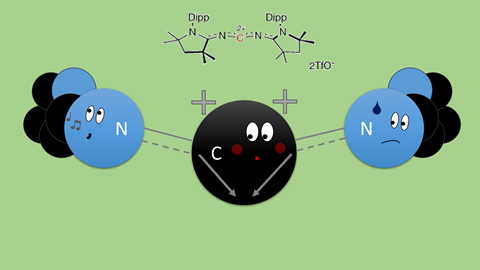For the first time, scientists have managed to remove the lone pair of carbene and isolate the resulting doubly oxidised molecule, US researchers report in Nature.
The synthesis itself is relatively straightforward. You start with an electron-rich bis(imino)carbene. First, you react the carbene with I2 and NaOSiMe3 to form a bis(imino)carbonyl. When you add triflate anhydride, this molecule removes the oxygen atom together with its electrons, leaving you with the doubly oxidised carbene2+. The nitrogenous side groups provide the C atom with the necessary electron density to make the whole thing stable.
The researchers then looked at the reactivity of the carbene2+. The carbene can be oxidised back to the bis(imino)carbonyl. The reaction with a neutral base such as DMAP or pyridine is also possible, as is methoxylation with dimethoxyethane, chlorination with trimethylsilyl chloride or a double reaction with hydride and C6F5-.
What is special is that the double oxidation of the carbene is reversible. Normally, such a two-electron redox system is only seen in transition metals, but the authors show that this p-block element can do it as well, confirming that it is indeed a double-oxidised carbene. They now hope to use this information to isolate more doubly oxidised carbenes.
Loh, Y.K. et al. (2023) Nature, DOI: 10.1038/s41586-023-06539-x













Nog geen opmerkingen